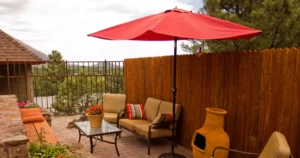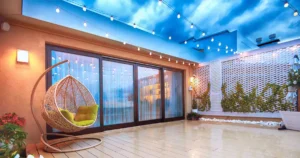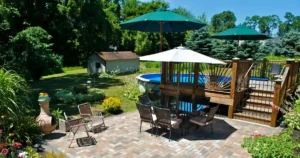Having patio furniture is great for enjoying the nice weather outside in style. But one downside is fighting with it in windy conditions! It’s no fun when your chairs and tables blow all over the place, and it can damage them over time too.
Luckily, there are easy ways to keep patio furniture from blowing away no matter how strong the winds get. In this guide, I’ll cover everything you need to know about how to keep patio furniture from blowing away. I’ll show you different anchor options for patios on grass, concrete, or other surfaces. You’ll also learn which attachments work best for certain pieces.
I’ll provide step-by-step instructions for installing everything securely. By the end, you’ll have foolproof methods for tying down chairs, tables, umbrellas and more so they don’t go anywhere when it’s windy. I’ll also give tips for storing furniture safely long-term.
Whether you have a small bistro set or a large dining table, the techniques in this guide will make sure your patio furniture stays put through every stormy day. No more wrestling with chairs or searching the yard when a gale hits! You’ll be able to relax outside without worry, come rain or shine.
Why Patio Furniture Blows Around
Before getting into solutions, let’s first go over some of the reasons patio furniture is susceptible to blowing around:
- It’s lightweight – Most patio furniture is designed to be portable and moved around easily. This makes them lighter weight and easier to blow around.
- Open spaces – Patios are open areas with no wind barriers, allowing gusts to easily sweep through.
- Elevated surfaces – Patios and decks are elevated above the ground, exposing furniture to more wind than at ground level.
- Wind tunnels – The spaces between buildings can create wind tunnels, causing winds to accelerate as they pass through patios.
- Weather changes – Storms and seasonal wind changes can bring sudden strong gusts that catch furniture unprepared.
Knowing the ways, the wind impacts patio furniture, makes it easier to find solutions to keep it in place despite these challenges.
Identifying Furniture That Needs Securing
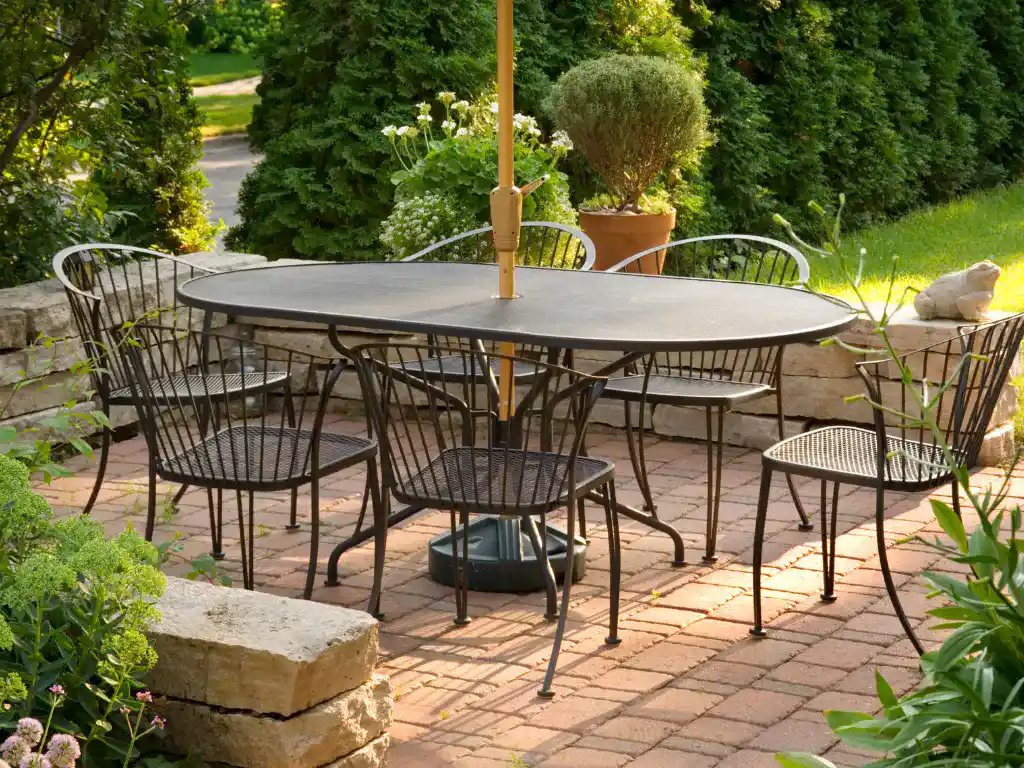
Not all patio items require anchoring. Heavier construction like teak, stone, or aluminum with a weighted base can usually withstand moderate gusts without issue. To focus securing efforts, first, identify lightweight furnishings more prone to blowing over:
- Plastic/Resin Chairs: Very lightweight without stability ballast.
- Small Bistro Sets: Lack mass with just a table and two thin-legged chairs.
- Adirondack Chairs: Sturdy but large sail area formed by high-winged backs.
- Umbrella Tables: Height & umbrella catch substantial wind like a small sailboat.
- Outdoor Sofas: While composite, multi-cushion designs lack the stability of built-in versions.
Play it safe by also anchoring questionable borderline items during severe weather warnings. The goal is to keep all potentially movable furniture securely in place.
Anchoring Methods Approved by Experts
To give patio furniture stability matching its intended leisurely function, a combination approach using several expert-recommended anchoring systems provides critical redundancy against wind forces from multiple angles:
Ground Stakes
Drive rugged plastic or metal stakes 6-12 inches deep by each leg, then secure all pieces together with nylon straps or rope.
- Pros: Inexpensive and easy to use
- Cons: May not work in very hard ground
Concrete Ballast
Concrete blocks, pipes, or solid disks provide discrete yet effective ballast hidden discreetly under furniture.
- Pros: Conceals the weight and looks neat
- Cons: Concrete is heavy to work with
Sandbags
Durable reusable bags filled with damp sand add movable extra weight where needed. Secure to prevent sliding.
- Pros: Allow adjustable weight placement and are reusable
- Cons: Not as aesthetically pleasing as concrete
Deck/Patio Anchors
For wooden areas, use anchors designed to screw securely into deck boards near each leg connection point.
- Pros: Fast and simple to use
- Cons: Damages the deck/patio surface
Straps & Tethers
Always connect individual furnishings together as a cohesive unit with flexible non-abrasive straps or rope through frames and around legs.
- Pros: Easy to use and binds furniture into a wind-resistant group
- Cons: Straps could potentially chafe or weaken over time
Outdoor Furniture Spikes
Hammer specialty exterior-safe spikes designed to grip surfaces directly into some wood, composite or concrete furnishings for rugged anchoring.
- Pros: Provide a very secure attachment
- Cons: Risk of damaging the furniture surface
Using multiple anchoring methods together provides redundancy and ensures patio furniture is safely anchored against the wind from all angles. No single method alone is as effective.
Securing Specific Furniture Types
To keep favorites secure, supplemental customized techniques may complement your anchoring systems:
Umbrella Tables
Add weight discreetly inside pole bases or secure closed during high alerts with outdoor-safe screws through frames.
Adirondack Chairs
Fill oversized attached pillows with sand inside waterproof bags, securing underneath for increased low-mounted ballast.
Small Bistro Sets
Place filled sandbags weighing 10-15 lbs. each under center of table and one under each chair for stabilization.
Outdoor Sofas
Add a long concrete patio block or sand-filled tube discreetly under center frame member to lower overall center of gravity.
Customizing another stabilizing layer tailored to individual furnishings’ vulnerabilities arms you to easily secure favorites confidently even during freak storms.
Securing Accessories & Decor

No patio is complete without decorative pillows, planters, flags and more but loose extras also become airborne projectiles in high winds. Protect these as well:
- Group & cover loose cushions and decor securely with painter’s plastic tarps tied with rope.
- Tie down planters, pots, statuary and hanging baskets with sturdy outdoor line anchored 6-8 inches into soil or fixed points.
- Stow away movable yard games, umbrellas and seasonal décor well before severe weather alerts.
Safeguarding all items lets you truly relax knowing your entire outdoor space is storm-ready without last-minute scrambles.
When to Secure Furniture
As a general guideline, most experts recommend securing patio sets any time winds are predicted to regularly exceed:
- 25 mph sustained – Anchor potentially lightweight items prone to shifting or sliding.
- 35+ mph with gusts – Secure all furniture, accessories, and decor as a precaution.
- Tropical storm watch – Days in advance, fully prep your entire patio per anchoring suggestions.
- Severe thunderstorm watch – Install anchoring systems as early as possible once alerts are raised.
Don’t take chances – being proactively prepared for sudden storms provides total peace of mind.
Choosing Anchoring Materials
When selecting anchoring materials, opt for durable, weather-resistant products suited for outdoor use. Avoid anything that could rust, rot, or decay over time when exposed to sun, rain, and seasonal temperature changes. A few good options to consider include:
- Nylon Straps/Rope – Flexible nylon fiber strands hold straps together securely yet stretch to prevent breakage. UV resistant for longevity.
- Plastic-Coated Steel Cable – Flexible like rope but stronger for heavier items, with a plastic sheath protecting the metal core from elements.
- Marine-grade polyester Webbing – High-tensile webbing withstands moisture and UV rays. Ideal for wraps, ties, and covers.
- Stainless Steel Hardware – Sharp screws, rings, and carabiners resist corrosion for anchoring to hardscapes.
- Concrete/Masonry Products – Blocks, and pipes provide permanent embedded ballast. Set in mortar for patio installs.
- Metal Stakes – Aluminum or galvanized steel stakes drive securely into the ground without rusting.
Avoid potential hazards like chains, twine, and wire which could fray or cut. Also skip flimsy materials prone to ripping apart when stressed. Investing in tough, seamless products suited for aerial moisture delivers years of dependable outdoor use.
Custom Anchoring Options
While standard methods work great, adjustable securement allows customizing setups for diverse outdoor areas. Consider these creative techniques too:
Tree Tethering
For patios near trees, thread rope high through branches to anchor items below.
- Landscaping Integration – Build retaining wall terraces doubling as below-grade concrete anchors.
- Deck Rail Tie-Downs – Slot stainless anchoring bars into deck rail spindles for strap attachment points.
- Membrane Ground Cover – Lay weighted tarps below furniture, staking outer edges only for subtle ground anchoring.
Creative solutions tailor anchoring seamlessly to any space. With adjustable securement, customize positioning furniture conveniently while still keeping it steadfast through storms.
Anchoring on Different Surfaces
Patio surfaces require adapting typical anchoring methods for best traction. Consider these surface-specific techniques:
- Grass – Deep-driven stakes grip well in grass but add soil-filled planters or underground weights for extra hold.
- Gravel/Decomposed Granite – Stake beside bagged weight sets instead of into loose gravel. Bury structures like brick walls below gravel level.
- Concrete – Auger or hammer anchors fully into the surface. For slab edges, bury concrete blocks at angles alongside underneath.
- Wood Decking – Low-profile screws through hidden deck seams. Stake through the spacing between boards. Test discreet locations first.
- Pavers – Stake between pavers if deep enough or rest edges of weighted objects on paver sides instead of penetrating surface.
- Sand/Soil – Bury-weighted tarps below grade secured from edge uplift. Build low retaining walls bordering the furniture area.
Tailoring attachment points optimizes each surface’s structural integrity while effectively securing furnishings through its material composition. Secure footing provides steadfast anchorage anywhere outdoors.
Anchoring Spacing Guidelines
Proper spacing between anchoring points maintains equal weight distribution across pieces. Here are general spacing guidelines for various items:
- Chairs – Attach anchoring straps every 12-18″ around chair legs and rails.
- Small tables – Space stakes, weights, or eye bolts every 12-16″ along the table perimeter.
- Large dining tables – Secure legs and cross beams at 12-24″ intervals depending on size.
- Sofas/Sectionals – Anchor frame joints and legs every 12-24″ and connect units together.
- Umbrellas – Place anchors at equidistant points around concrete/sand-filled bases.
- Planters/Accessories – Space anchor ties every 6-12″ depending on size and wind resistance.
Closer spacing over 12″ distributes stresses evenly without over-anchoring. Wider than 24″ can create top-heavy leverage points. Adjust as needed to suit specific conditions and forecasts. Consistent spacing is key for balanced security.
Anchoring During Installation
For patio makeovers, consider anchoring while assembling rather than as an afterthought. Here’s how to anchor pieces seamlessly during the initial setup:
- Dig postholes and secure ground anchors into fresh concrete footings before concrete cures.
- Run eye bolts through wooden beams and stake them to the ground before final deck attachment.
- Drill lag screws down through tables before placing glass/wood tops to link legs together extra rigidly.
- Bolt patio slabs together leveraging bolts to act as below-grade earth anchors fixed between units.
- Install rebar stakes and secure strap attachment points in wet concrete patio borders.
Anchoring during construction saves time versus retrofitting later and takes advantage of wet concrete/soil for superior anchorage. Factor it into plans from the beginning.
Testing & Adjusting Systems
Before storms arrive, test anchoring alignment and tension points:
- Rock furniture gently side-to-side and forward/back to ensure stability. Readjust as needed.
- Check straps/ropes aren’t pulling out of stakes or chafing. Replace if worn prematurely.
- Ensure all connections are taut without overly constraining movement.
- Simulate planned tethering arrangements under light loads to work out any kinks.
After severe weather, re-examine integrity. Strengthen any compromised areas discovered during testing. Periodic assessments optimize setups for maximum protection through the seasons.
Anchoring Maintenance Tips
Proper ongoing care maintains anchoring system dependability through seasons and storms:
- Inspect straps, ties and fittings each spring for winter damage before use. Replace as needed.
- Sand and repaint any metal surfaces like stakes that show rusting to prevent corrosion spreading.
- Re-tension and tighten all connections periodically as materials age and compact over time.
- Wash concrete blocks/weights and allow them to fully dry periodically to remove any accumulated algae growth.
- Store anchoring components safely bundled together with furniture put away for winter in organized storage.
- Test systems fully before each season’s first use then monthly during active months.
Keeping anchoring supplies in ready working order provides reassurance your securement strategies will perform as planned without fail when needed most.
Final Thoughts
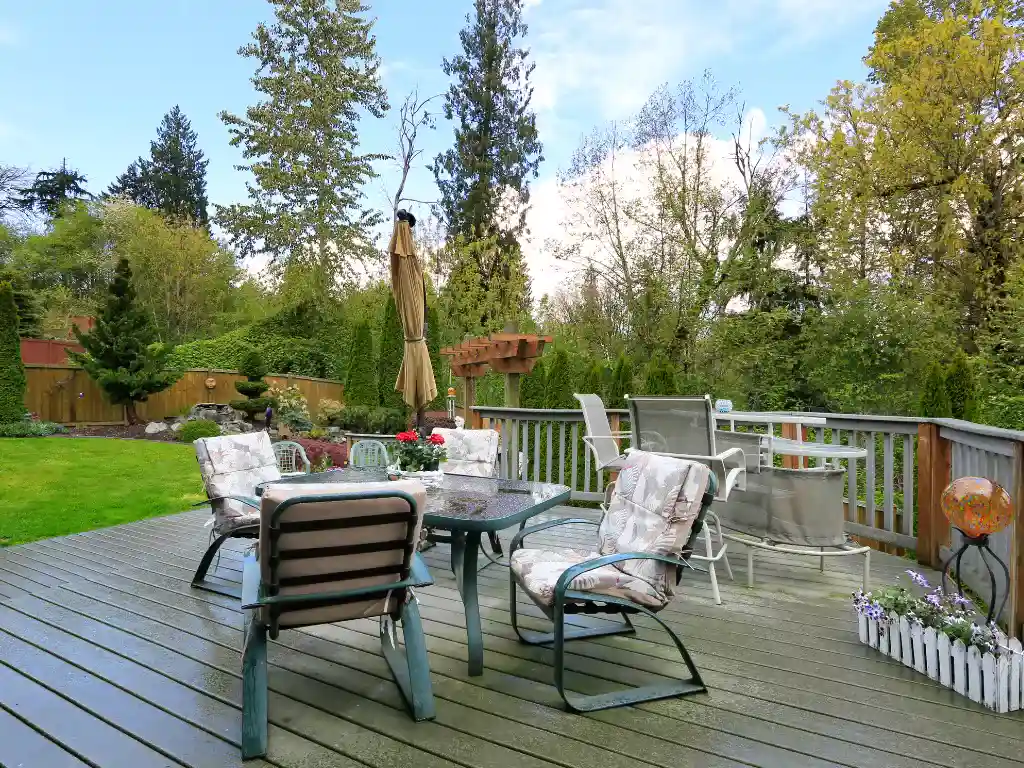
By following the anchoring techniques outlined in this guide, you can feel confident that your patio furniture will stay securely in place, even during strong wind events. Taking some simple precautions like staking furniture to the ground, adding ballast, and strapping items together will protect your expensive outdoor pieces from blowing all over your yard.
With the right multi-point anchoring system, you’ll be able to continue enjoying relaxing in your outdoor space without worry of wind damage. I hope you now feel armed with the anchoring knowledge you need to keep furniture safely stationed so that storms can’t ruin your patio plans. Happy relaxing – and hurricane-proof enjoying! – of your outdoor living area.
Frequently Asked Questions (FAQs)
Q: How often do I need to check my patio furniture anchors?
It’s a good idea to inspect your patio furniture anchors at least a couple times each season, or any time after strong storms. Make sure all straps and ties are still securely fastened and the hardware isn’t loosening over time. Tighten or replace anything that shows signs of wear.
Q: What’s the best way to store patio furniture over winter?
For winter storage, bring the furniture inside if possible or cover it securely with heavy-duty tarps and tie it down tightly if keeping it outside. Ensure straps or ropes won’t loosen in freeze/thaw cycles. Anchors can remain installed year-round if using non-corrosive hardware.
Q: Will anchoring damage my outdoor surfaces?
Using the right anchoring methods minimizes surface damage. For decks, seek temporary anchoring options that don’t require screwing directly into the wood. On patios, direct ground stakes or weighted balls are gentler than permanent hardware. Test discreet anchor points first if concerned.
Q: Can I reuse sandbags each season?
Yes, reusable sandbags for anchoring patio furniture can be used year after year. Store empty over winter to prevent dampness. Before reusing, check bags for flaws and refill them with clean sandbox sand as needed. Replace any that show significant wear and tear.
Q: Will anchoring work for furniture on my second-story balcony?
Extra precautions are needed to anchor patio furniture on higher levels. Use heavier securement like bond stone ballast versus stakes. Double straps on all joints. In very windy areas, safely remove lightweight items and securely store them inside if a balcony cannot withstand extreme gusts.
Q: Do I really need multiple anchoring methods?
Yes, using two or more anchoring techniques in combination provides redundancy critical for security. No single method alone can account for strong, variable wind forces from multiple angles. Combined stakes, straps and ballast distribute weight low and connect all pieces securely together as a unit.



